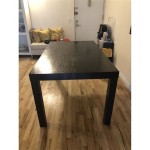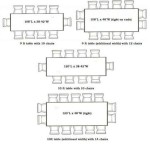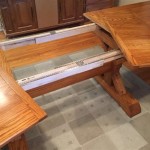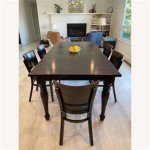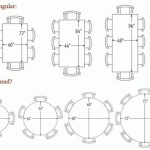Creating a Harmonious Living Room with Dining Table: Design Ideas
Combining a living room and dining area into a single, unified space is a common necessity in modern homes, particularly in apartments, smaller houses, or open-plan designs. This combination requires careful planning and thoughtful design considerations to ensure both functionality and aesthetic appeal. The key lies in creating a cohesive environment where the living and dining spaces complement each other, without feeling cramped or disjointed. This article explores various design ideas for integrating a dining table into a living room, focusing on layout, furniture selection, and visual coherence.
The successful integration of a dining table into a living room hinges on a clear understanding of the available space and its limitations. Before any design decisions are made, individuals must measure the room accurately and consider the natural flow of movement. Analyzing existing architectural features, such as windows, doorways, and fireplaces, is crucial. These elements can influence furniture placement and overall layout. The goal is to create a space that feels both inviting and functional, accommodating both relaxation and dining without compromising either activity.
Optimizing Space with Strategic Layout
One of the primary challenges in combining a living room and dining area is maximizing space utilization. Several layout strategies can be employed to achieve this. One common approach is to delineate the dining area near a window or a wall, creating a distinct zone within the larger space. This can be achieved by strategically positioning the dining table and chairs, defining the boundaries of the dining area. A rug placed beneath the dining table can further emphasize this separation, visually distinguishing the dining space from the living area.
Another effective strategy involves utilizing open-concept layouts that seamlessly blend the two areas. In this approach, furniture placement is key to defining zones without creating physical barriers. For example, a sofa can serve as a visual divider between the living and dining areas, creating a sense of separation while maintaining an open flow. The placement of accessories, such as lamps, artwork, and plants, can also contribute to defining distinct areas within the room.
In smaller spaces, multi-functional furniture is particularly valuable. A drop-leaf dining table, for instance, can be extended when needed for meals and folded away when not in use, freeing up valuable floor space. Similarly, storage benches can provide seating at the dining table while also offering storage space for items such as linens or toys, maximizing the utility of the furniture.
Consider the flow of traffic when planning the layout. Avoid placing furniture in areas where it might obstruct movement, creating bottlenecks or making the space feel cramped. Ensure that there is adequate space around the dining table for chairs to be pulled out and for people to move comfortably around the table. The goal is to create a layout that is both functional and inviting, promoting easy navigation and a sense of openness.
Selecting Furniture for Cohesion and Functionality
The selection of furniture plays a critical role in creating a cohesive and functional living room with a dining table. The furniture should not only be aesthetically pleasing but also appropriate in scale and proportion to the size of the room. Overly large furniture can overwhelm a small space, while furniture that is too small can make the room feel disjointed.
When choosing a dining table, consider its shape and size in relation to the space available. Round dining tables are often a good option for smaller spaces, as they promote conversation and can be easily navigated around. Rectangular dining tables are suitable for larger spaces and can accommodate more people. The table's material should also be considered. A wooden table can add warmth and natural texture to the space, while a glass-topped table can create a sense of openness and airiness.
The dining chairs should complement the style of the dining table and the overall aesthetic of the living room. Consider using chairs with a back height that is similar to the height of the sofa to create visual harmony. Upholstered chairs can add comfort and softness to the dining area, while minimalist chairs can contribute to a more modern and streamlined look. Mixing and matching chairs can add visual interest, but it is important to ensure that they share a common element, such as color or material, to maintain a sense of cohesion.
The living room furniture should be chosen to complement the dining area furniture in terms of style, color, and material. Consider selecting a sofa and armchairs that are in a similar color palette to the dining chairs to create a unified look. The coffee table should be appropriately sized for the sofa and should be placed at a comfortable distance from the seating. Storage solutions, such as bookshelves and cabinets, can help to keep the living room organized and clutter-free, contributing to a more inviting and relaxing atmosphere.
Multifunctional furniture is particularly useful in combined living and dining spaces. Consider using a coffee table with storage drawers or a console table that can double as a side table for the dining area. Ottomans can provide additional seating and can also be used as footrests or coffee tables. The key is to choose furniture that serves multiple purposes, maximizing the functionality of the space.
Establishing Visual Coherence Through Color, Texture, and Lighting
Creating visual coherence between the living and dining areas is essential for a harmonious and well-designed space. Color plays a crucial role in achieving this. Choosing a consistent color palette throughout the room can create a sense of unity and flow. This does not mean that everything has to be the same color, but rather that the colors should complement each other and create a cohesive look.
Consider using a neutral color palette as a base and adding pops of color through accessories, such as cushions, throws, and artwork. These pops of color can be used to tie the living and dining areas together, creating a sense of visual harmony. Alternatively, individuals can use different shades of the same color to create depth and interest while maintaining a cohesive look.
Texture is another important element in creating visual coherence. Mixing different textures can add depth and interest to the space. Consider incorporating materials such as wood, metal, fabric, and glass to create a layered and inviting look. For example, a wooden dining table can be paired with upholstered chairs and a soft rug to create a balance of textures. Similarly, a metal coffee table can be paired with a plush sofa and cushions to add visual contrast.
Lighting is essential for creating the right atmosphere in both the living and dining areas. Layered lighting is the most effective approach, combining ambient, task, and accent lighting to create a balanced and versatile space. Ambient lighting provides overall illumination and can be achieved through ceiling fixtures or floor lamps. Task lighting is used for specific activities, such as reading or dining, and can be achieved through table lamps or pendant lights. Accent lighting is used to highlight specific features, such as artwork or architectural details, and can be achieved through spotlights or wall sconces.
In the dining area, consider using a pendant light or chandelier above the dining table to create a focal point and provide task lighting. In the living area, use table lamps and floor lamps to create a warm and inviting atmosphere. Dimmers can be used to adjust the lighting levels to suit different activities and moods. The goal is to create a lighting scheme that is both functional and aesthetically pleasing, enhancing the overall ambiance of the space.
Finally, accessories play a vital role in tying the living and dining areas together. Artwork, plants, and decorative objects can be used to add personality and visual interest to the space. Choose accessories that complement the overall style and color palette of the room. Consider using similar accessories in both the living and dining areas to create a sense of cohesion. For example, individuals can use matching vases on the dining table and the coffee table, or they can hang artwork that features similar colors and themes in both areas. The key is to choose accessories that reflect individual style and create a welcoming and inviting atmosphere.
Integrating a dining table into a living room requires careful consideration of space, furniture selection, and visual coherence. By employing strategic layout techniques, selecting furniture that is both functional and aesthetically pleasing, and establishing visual coherence through color, texture, and lighting, it is possible to create a harmonious and well-designed space that meets individual needs and preferences.

Living Room And Dining Design Ideas Designcafe

54 Simple Ideas For Small Living Room Dining Combo Edward George

Living Room Dining Combo Ideas With Tricks Doğtaş

15 Small Living Room Ideas With Tv And Dining Table

Living Room Dining Combo Ideas With Tricks Doğtaş

54 Simple Ideas For Small Living Room Dining Combo Edward George

How To Layout Small Living Dining Combos 25 Creative Ideas Gws Masonry Home Improvement

39 Living Room Dining Combos To Maximize Your Space

Living Room And Dining Design Ideas Designcafe

Living Room Decorating Ideas How To Decorate A Small

